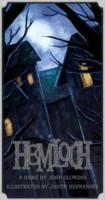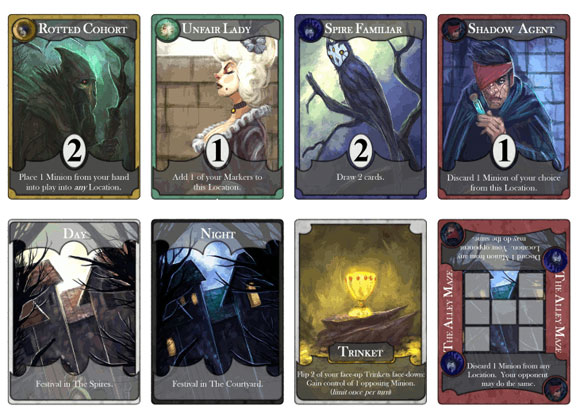
Hemloch
Twilight has loomed for decades. Rumors of the coming sun run across the city's dark alleys and corrupted courtyards. Impromptu festivals catch like wildfire as the denizens of the dark city usher in the Season of the Sun. You have precious few nights of perpetual moonlight remaining to secure your bloodline's grip on the great districts before the moon sets; because once the sun rises, all your deeds will come to light, and a new age will dawn on Hemloch.

Hemloch, a card game for 2 players, has player accessing their own deck of Minions including minions from the city's largest 5 factions: The Darkened, The Ghouls, The Geared, The Alchemists, and The Courtesans. These minions are played into various Locations, representing powerful districts. Each Minion has a unique special ability, but also, each Location offers a Special Ability when specific Minions are played there, making for a wealth of various special abilities that a player can access. With the optional Drafting rules, players can create new Minion decks with each game.
User Reviews (2)
Add a Review for "Hemloch"
You must be logged in to add a review.

I love games with unique themes. I particularly like them if they can do a good job of evoking those unique themes in a way that makes sense. Some people don’t really care about themes – that’s why there are a billion games about being a merchant in the middle ages, or building a railroad. (I’m not knocking train games – I have a few that I really like – but exactly how many do we need, really?) On the other hand, some games have really bizarre themes. Hemloch, the latest from John Clowdus and Small Box Games, is one of those games. Hemloch is a city that exists in perpetual night that is gradually coming to an end. Apparently, once the sun comes up, all **** is going to break loose or something, because you need to gain power before that happens. Your minions are going to see to it that you’re in control when Day breaks on Hemloch. I think I’m safe in saying that I’ve never played anything like that before.
Small Box is developing a habit of producing really fantastic looking games. Omen and Shattered Aegis had amazing art, and Hemloch continues this trend. Stylistically, it’s quite different from Omen, but it has in common its high quality and strong evocation of the theme. Hemloch is a lighter game, and the art reflects that – it has a whimsical, almost cartoonish quality to it that feels appropriate. The aesthetic has an almost Tim Burton-like quality, with a spooky air that reminds me of Halloween. It’s dark but not grim, creepy but not sinister. I enjoy it thoroughly.
Hemloch will undoubtedly be compared to Omen in terms of gameplay as well. Mechanically, it shares a few common elements, but it takes those mechanics in such a different direction that the comparison won’t survive the first game. Omen is like a knife fight in a phone booth; Hemloch is more like court intrigue. Players are attempting to gain control of the four Locations that make up the city. This is done by playing Minions to these Locations. Each minion has an influence value that is used to determine control of the location and a special ability that is triggered when the minion is played. In addition, each minion belongs to one of five factions. Each location is home to one of the factions, giving minions from that faction an influence bonus; in addition, each location has an ability triggered by minions from another faction. Players will always perform a minion’s special ability, but location abilities are only activated when a minion is played from the location’s activating faction.
The game is played across a series of Weeks that are represented by the Week deck. This deck consists of one card for each location designated either Night or Day. These cards are revealed one at a time until the deck is exhausted, ending the week. When a location’s card is revealed, the Festival marker is placed on that location, preventing play of minions there while the Festival remains. At the beginning of the game, the Week deck only contains Night cards; as the game progresses, these cards will be replaced with the corresponding Day card for that location. At the end of the week, an Influence Check is conducted at each location; the player with the most influence at each location places one of his or her markers on that location. Markers are each worth one point at the end of the game, two if the marker is touching another of that player’s markers. In addition, an influence check is also conducted at a location when its corresponding Day card is revealed from the Week deck.
Gameplay is very simple – players have two actions available, draw a card or play a card, and may take two actions on each turn. After both players have taken a turn, the next card from the Week deck is revealed, the Festival is moved, and any influence checks required are conducted. An additional action may be taken if the player has a Potion card to use, however, this isn’t always an easy choice, as Potions are worth two points at the end of the game if unused, but only one if used (similar to Omen’s Rewards). Trinkets function in much the same way, but using two will allow a player to gain control of an opponent’s minion. Both Potions and Trinkets are gained through use of certain Minion and Location Special Abilities. The end game is triggered on one of several different conditions: players have filled all openings on two locations with markers, the last Day card is added to the Week deck, one player has exhausted either his deck or his markers, or all Potions and Trinkets have been claimed and points are calculated.
This is a difficult game to describe. It isn’t complicated to play, but it does have a number of diverse elements that are rather unique. Gamers familiar with Omen will find themselves at times in familiar territory, but as I mentioned previously, even design elements that are similar feel much different in this game. Hemloch is, essentially, an area control game distilled into card form. This hybrid creates some interesting tensions – because card draws are by nature random, the game has a high tactical element, with turn-by-turn decisions often focusing on how best to utilize the hand that you’ve been dealt, and yet players need to plan ahead to try to end the game at a time that’s most advantageous for them. As I’ve come to expect from a John Clowdus design, each card can be played with multiple purposes, whether to trigger its own ability or the ability of a target location, or alternately to secure influence in a particular location. These purposes aren’t mutually exclusive, by any means, but the design does mean that it’s very rare to have a dead card in hand. I love to see that kind of design in a game, because it results in an increase in decision points and a corresponding increase in tension and interesting gameplay. As the game progresses and the number of Day cards in the week increase, the pace accelerates and players must be prepared for an increasing number of influence checks, but they also have an increasing control over where those checks will take place. At first, the number of possible ways to trigger end game can seem overwhelming, but in reality that flexibility allows players to craft a strategy that attempts to end the game at the most opportune time.
Hemloch plays quite well above the table. It does have a certain amount of screwage – Minions can be assassinated or stolen, and markers can be discarded or converted. But it never gets quite as nasty as Omen does, and for some reason the game state never feels as volatile. Additionally, Hemloch offers more opportunities for bluffs and feints, which I appreciate. The interaction is meaningful and substantive, decisions real and consequential, but the game doesn’t bog down and manages to retain a very reasonable play time of 30-45 minute without feeling like a filler. In all, Hemloch represents yet another fantastic game from John Clowdus and Small Box, one that looks as good as it plays.
A wonderfully short and brutal cardgame for 2-4 players. I’ve never had a bad game and everyone I’ve played it with has enjoyed it, from my casual friends to my war-gaming friends. The only stipulation I have is the rules can be a bit vague, but a careful second read-over generally gets you the answer you need. The art is wonderful and the colours schemes add to the horror-themed world of Hemloch.